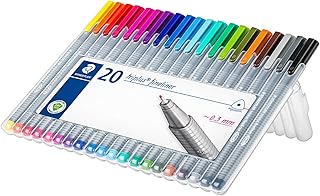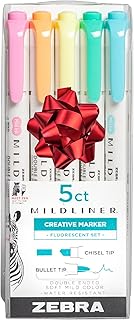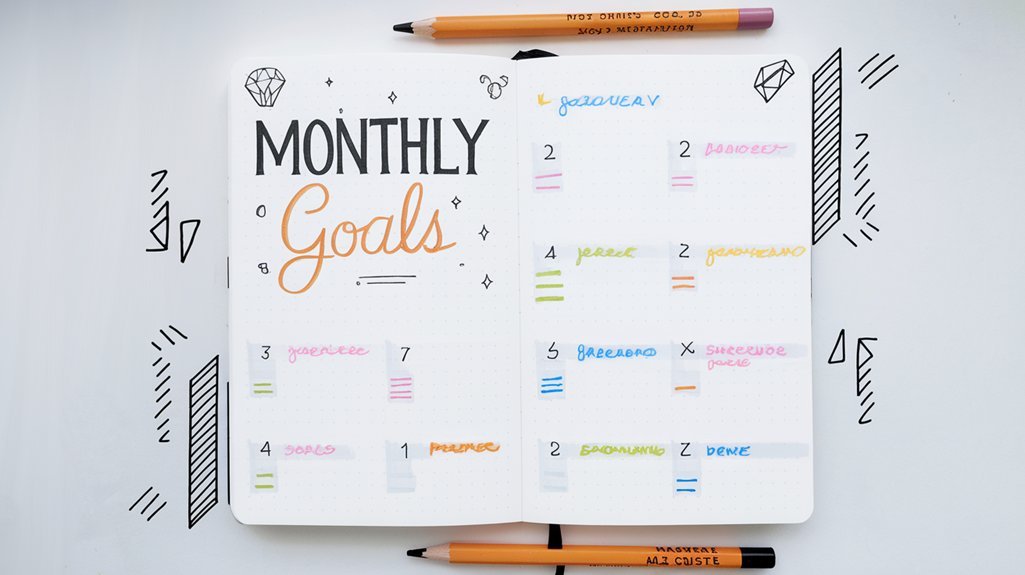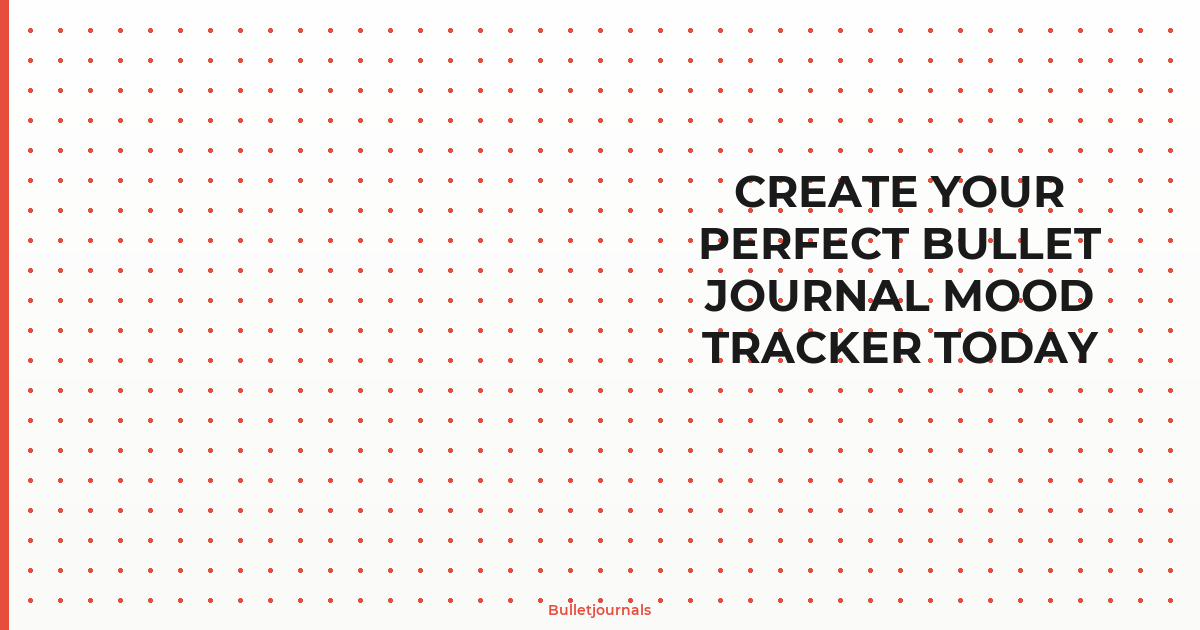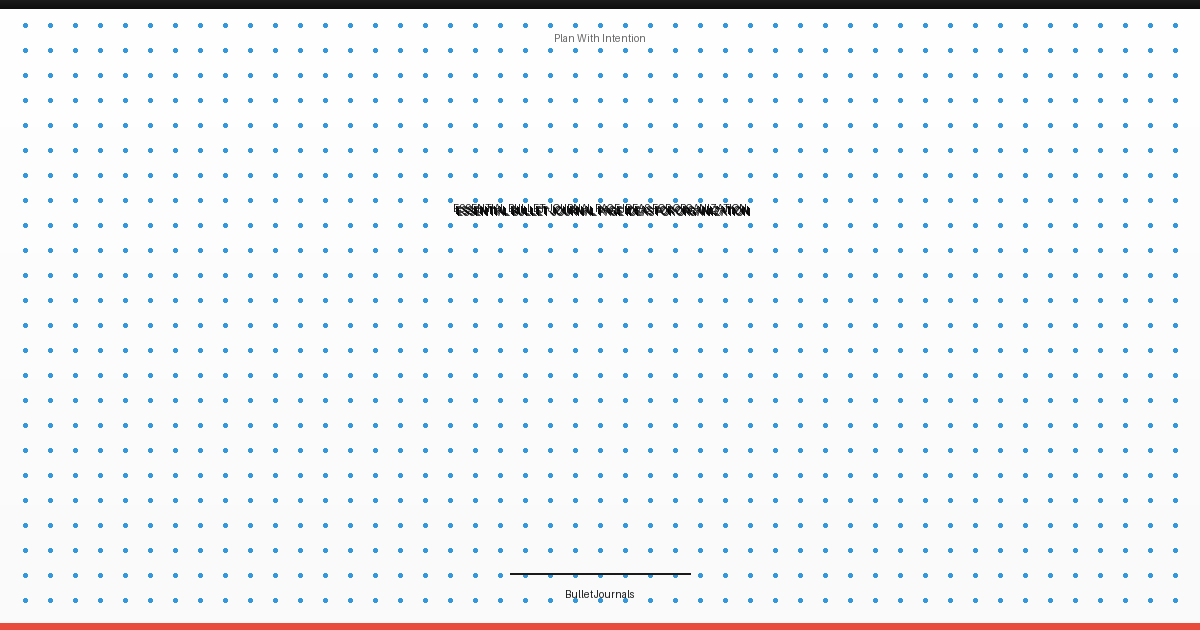Bullet journal habit trackers range from classic grid layouts to innovative circular designs, offering diverse ways to monitor daily routines. Popular styles include Dutch door spreads for multi-category tracking, minimalist box systems for essential tasks, and seasonal layouts with artistic illustrations. Weekly formats utilize color-coding while vertical columns enable systematic progress monitoring. Mood tracking combinations provide holistic insights, and geometric patterns add creative flair. These proven tracker designs open the potential for meaningful personal growth and achievement.
The Simple Grid Layout: A Classic Monthly Tracker
Looking to start habit tracking in a bullet journal? The simple grid layout offers a classic Monthly Habit tracking system that's perfect for beginners and experienced journalers alike. This time-tested format features a straightforward design that maximizes functionality while maintaining visual clarity.
The Bullet Journal Habit Tracker grid arranges days of the month horizontally across the top, with targeted habits listed vertically down the side. Users can easily mark completed habits daily, creating a clear visual representation of their progress throughout the month. The layout's simplicity makes patterns and missed days immediately apparent.
What makes this tracker particularly effective is its adaptability. While maintaining its basic grid structure, users can personalize their habit tracking experience through color coding, symbols, or decorative elements. This combination of practical design and customization potential has established the simple grid layout as a foundational element in the bullet journal community.
Circular Progress Trackers for Year-Long Goals
Degree-based progress rings transform annual goals into elegant 360-degree circles, with each segment representing specific time intervals or achievement milestones. These circular trackers utilize concentric rings to monitor multiple habits simultaneously, allowing users to color-code completed segments as they progress throughout the year. Monthly ring layouts divide the circle into twelve equal sections, creating an intuitive visual system that instantly reveals patterns and completion rates across different seasons or periods.
Degree-Based Progress Rings
Progress rings stand among the most elegant solutions for tracking year-long habits in bullet journals. Based on a circular habit design, these degree-based trackers divide the dot grid into precise segments representing monthly or weekly increments. The year in pixels concept takes on a radial form, allowing users to monitor multiple habits simultaneously through concentric circles.
The mathematical precision of 360-degree segmentation offers versatile tracking options, with common layouts featuring 12 monthly sections or 52 weekly divisions. Users can enhance their habit tracking by implementing color coding systems or creating nested rings to monitor both monthly and annual progress. The visual satisfaction of completing each segment provides powerful motivation, making progress rings particularly effective for consistent habits like reading, exercise, or daily water intake goals.
Monthly Ring Goal Layouts
When bullet journal enthusiasts seek an elegant solution for tracking annual objectives, monthly ring goal layouts offer a compelling circular framework that transforms year-long aspirations into manageable 30-day segments. These bullet journal spreads divide a circle into twelve equal sections, with each wedge representing one month of progress toward specific goals.
The versatility of monthly ring layouts in bullet journaling allows for creative customization through color coding, symbolic icons, and personalized design elements. As each month progresses, journal users can fill in their rings, creating a visually striking representation of their journey toward completion. This circular tracking method proves particularly effective for monitoring habits, fitness milestones, and other quantifiable goals. The organized structure helps bullet journal practitioners maintain consistency while easily identifying trends in their goal-achievement patterns throughout the year.
Dutch Door Design for Multiple Habit Categories

The Dutch door design revolutionizes habit tracking by transforming a standard bullet journal spread into a multi-layered system of categorized sections. By horizontally cutting the page, this layout enables users to create distinct areas for mini habit trackers while maintaining an exhaustive overview of their progress.
| Category | Layout Style | Tracking Period |
|---|---|---|
| Health | Weekly Habit | Monthly View |
| Fitness | Ring Design | Daily Progress |
| Mood tracker | Color Coding | Weekly Summary |
This innovative approach allows bullet journalists to monitor different habit categories simultaneously without compromising organization or visual appeal. The sectioned layout proves particularly effective for those tracking numerous habits across various life areas. Each cut section can be customized with unique colors and designs, creating a visually striking and functional spread. The Dutch door method optimizes space utilization while maintaining the accessibility of all tracking information, making it an efficient solution for thorough habit monitoring.
Mini Weekly Trackers With Color-Coding
Mini weekly habit trackers offer a streamlined approach by combining efficient space utilization with visual clarity through color-coding. The compact format allows users to track multiple habits while maintaining an organized weekly spread, preventing the overwhelming feel of larger tracking systems. Strategic use of colors helps distinguish between different habit categories at a glance, making it easier to identify patterns and maintain consistency in daily tracking practices.
Color-Code Weekly Tasks
Smart organization meets visual appeal in color-coded weekly habit trackers, which combine compact layouts with intuitive color systems to monitor multiple tasks efficiently. Using washi tape and vibrant markers, each habit receives a distinct color designation, allowing for quick visual identification of various activities, from sleep tracker patterns to exercise routines.
The color-coding system creates a streamlined approach to habit monitoring while maintaining a clean, organized appearance. This method enables users to Akismet to reduce visual clutter while maximizing information density in a limited space. By assigning specific colors to different tasks, patterns and trends become immediately apparent, making it easier to identify areas of success and those requiring improvement. The compact format proves particularly effective for maintaining long-term consistency while providing an aesthetically pleasing overview of weekly progress.
Compact Layout Benefits
While larger tracking systems can become overwhelming, compact mini weekly trackers offer remarkable efficiency through their streamlined design and space-saving layout. The compact layout enables quick progress checks while maximizing valuable journal space.
| Benefits | Implementation |
|---|---|
| Space Efficiency | Vertical stacking |
| Visual Impact | Color-coding system |
| Time Management | Quick daily entries |
| Pattern Recognition | At-a-glance review |
Color-coded mini trackers facilitate pattern identification and trend analysis through their simplified format. This site uses Akismet to reduce spam, ensuring a clean interface similar to how Free Printable Habit trackers maintain clarity through minimalist design. The streamlined approach of these compact layouts promotes consistency by reducing the time investment needed for daily tracking. By stacking multiple habits vertically, users can monitor several behaviors simultaneously while maintaining the tracker's simplified essence.
Vertical Column Style for Daily Progress

When organizing multiple daily habits in a bullet journal, the vertical column style tracker stands as one of the most efficient and visually appealing layouts available. The format enables users to monitor every single task systematically, with each column representing a day of the month. Using a habit tracker in this vertical arrangement creates an intuitive system for marking daily accomplishments, from exercise routines to cleaning tracker entries.
The layout's effectiveness lies in its straightforward visual presentation, allowing users to track multiple habits simultaneously while maintaining a clear overview of their progress. Each vertical column can be customized with colors, symbols, or personal touches to enhance engagement and motivation. Whether monitoring water intake, meditation practice, or daily chores, the vertical format provides immediate feedback on consistency and patterns. This arrangement proves particularly valuable for those seeking to establish and maintain regular routines while keeping their tracking system organized and aesthetically pleasing.
Mood and Habit Combination Spreads
The strategic pairing of habit and mood trackers on a single spread creates a powerful tool for understanding the relationship between daily routines and emotional well-being. Organizing these trackers side by side enables users to identify patterns between specific habits and their impact on mood, while maintaining visual harmony through consistent design elements and color schemes. Effective combination spreads integrate decorative elements like Martha's nature-inspired illustrations while preserving ample space for both tracking systems, resulting in a functional and aesthetically pleasing layout that promotes holistic self-reflection.
Synergistic Tracking Benefits
By combining mood and habit trackers in a single bullet journal spread, users can discover powerful insights into the relationship between their daily routines and emotional states. The structured layout of dual tracking provides a clear, organized system to comment data at the end of the day, revealing patterns between behaviors and emotional well-being.
Martha's spread serves as a great example of how thoughtful design can enhance tracking effectiveness. Her cohesive color scheme and decorative elements make the process more engaging, while maintaining functionality. Similarly, Ivana's scrapbook-inspired layout demonstrates how to track in your bullet journal with both purpose and visual appeal. The integrated approach allows users to spot correlations between habits and moods, enabling them to make informed adjustments to their routines for improved overall health and productivity.
Layout Design Tips
Designing effective combination spreads requires careful consideration of both spatial organization and visual elements. When creating something that merges habit and mood tracking, users should allocate space strategically to guarantee both components remain functional while maintaining aesthetic appeal.
There are different ways to set up these combination layouts, as exemplified by Martha's spread, which successfully balances decorative elements with practical tracking space. Next time you plan a spread, consider incorporating artistic touches like leaf drawings and doodles to enhance visual interest without compromising functionality. The layout should accommodate a lot of things while maintaining clarity – from mood indicators to habit checkboxes. A cohesive color scheme and theme tie these elements together, creating a spread that's both practical for data collection and visually engaging for daily use.
Minimalist Box System for Essential Tasks

When simplicity meets functionality, a minimalist box system emerges as one of the most efficient habit tracking methods in bullet journaling. Using just one page, this system creates a streamlined grid of small boxes representing daily tasks throughout the whole year. Each box serves as a visual checkpoint, allowing users to mark completed habits with a simple dot, cross, or shading.
The minimalist approach eliminates unnecessary decorative elements, focusing instead on pure functionality. Users are able to see their progress at a glance, with completed tasks forming clear patterns across the grid. For those who try a different tracking method each month, this system offers the flexibility to modify box sizes, symbols, or categorizations while maintaining its clean aesthetic. The layout accommodates both essential daily routines and occasional tasks, making it particularly effective for tracking medical appointments, exercise routines, water intake, or meditation practices.
Themed Seasonal Trackers With Illustrations
Seasonal themes transform habit trackers into visually engaging spreads that celebrate nature's changing rhythms throughout the year. Using Staedtler Triplus Fineliners and pastel highlighters, bullet journalers can create distinctive weekly spread designs that complement each season's unique characteristics.
Spring trackers feature delicate hand-drawn illustrations of blooming flowers and tender buds, providing an uplifting backdrop for wellness routines. Summer designs incorporate vibrant botanical elements and sunshine motifs, while autumn spreads showcase warm-toned pumpkins and falling leaves to track productivity goals. Winter trackers utilize crystalline snowflakes and evergreen branches, creating a cozy atmosphere for monitoring self-care habits.
These themed layouts serve a dual purpose: they maintain accountability while allowing creative expression through artistic elements. The combination of functional tracking systems with seasonal illustrations transforms routine habit monitoring into an aesthetically pleasing journey that adapts and evolves with each passing season.
Calendar-Style Layout With Icon Markers
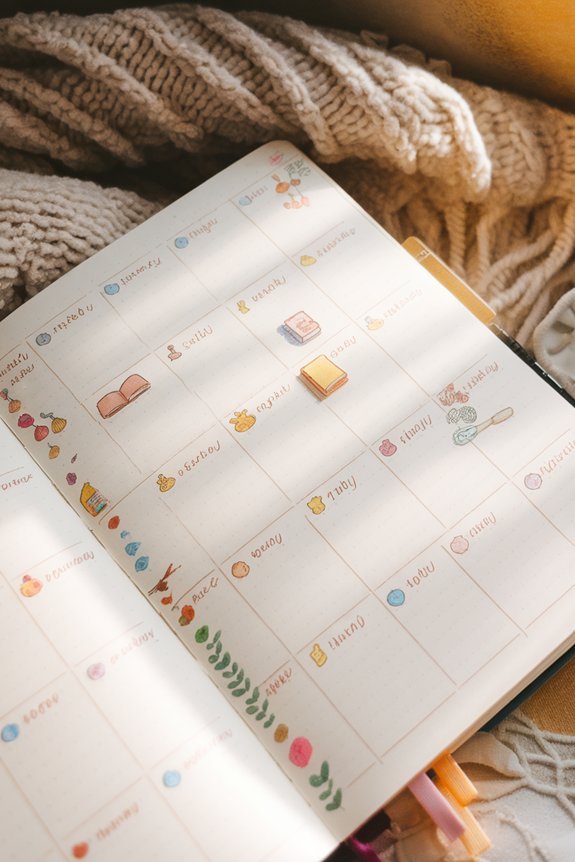
A calendar-style habit tracker offers one of the most systematic approaches to monitoring daily routines through its familiar grid structure and versatile icon system. When browsing for the next perfect layout, this format stands out for its clean organization and visual clarity. Please see my disclosure: some website in this browser may receive a small commission when sharing these tracking methods.
| Icon Options | Best Uses |
|---|---|
| Checkmarks ✓ | Daily tasks |
| Hearts ❤ | Self-care habits |
| Stars ⭐ | Major achievements |
| Dots • | Simple completion |
| Circles ○ | Progress tracking |
The calendar grid naturally accommodates both daily and monthly tracking needs, allowing users to observe patterns and trends over time. Its standardized format makes it simple to adjust habits as goals evolve, while the icon markers provide quick visual feedback on progress. This systematic approach helps maintain consistency in habit formation while offering flexibility for personalization and adaptation.
Geometric Pattern Trackers for Creative Goals
Countless creative minds have discovered that geometric pattern trackers offer an artistic approach to monitoring creative goals and habits. This post may contain affiliate links to supplies that transform standard habit tracking into visually enchanting designs using triangular and hexagonal grids.
Circular trackers, which use Akismet to reduce visual clutter, create elegant monthly progress wheels that make artists and writers much more motivated to maintain their practice schedules. These layouts contain affiliate opportunities for customization, allowing creators to design intricate patterns that reflect their artistic sensibilities while monitoring their creative development.
The symmetrical nature of geometric trackers brings structure to typically fluid pursuits like painting, writing, and musical practice. By incorporating interlocking shapes and balanced patterns, these trackers transform routine documentation into an engaging visual experience. The result is a harmonious blend of organization and artistic expression that enhances commitment to creative goals through aesthetic appeal.
Conclusion
Bullet journal habit trackers serve as personal accountability mirrors, reflecting daily choices and progress like constellations mapping a journey through time. These ten versatile layouts offer something for every journaling style, from minimalist grids to artistic seasonal spreads. Whether tracking fitness goals, reading habits, or self-care routines, implementing these proven designs transforms abstract intentions into measurable achievements while maintaining organization and motivation.
Habit Tracking Supplies
Affiliate links – we earn from qualifying purchases.


